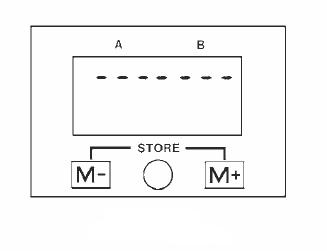Navigation
MIH LCD / software facility
A and B-axis positional data is shown on an integral liquid crystal display (LCD). When the head is unlocked and repositioned, position detectors fitted in each axis update the display which will show live position data. Power for the LCD / software is supplied by a battery fitted within the head which should be replaced when the low battery indicator is shown. Under normal use, the head will still function for many days after the low battery indicator appears.
The MIH also has a user-friendly software facility which is operated by two buttons. The software facility operates in four modes which are entered and exited by button presses and / or time-out periods of non-use. The locked symbol and low battery indicator function in all modes.
Datum mode
This mode has automatic entry when the battery is first fitted or replaced. Datum mode requires the user to set the A and B-axis position detectors to zero and must be completed successfully before the LCD can be used. Datum mode may also be automatically entered if an error occurs in the axis position detectors, caused by mis-use of the head. Again, correct datuming of the head must be completed before use can commence. See 'Datum mode' for step-by-step instructions.
Simple mode
The software automatically enters simple mode upon completion of the datuming routine. Following the time-out of other modes, the MIH software will always return the user to simple mode. This is a use-only mode in which live A and B-axis data will always be shown.
In addition, if the head is locked in a position which corresponds to one which has been previously stored in memory, the memory number will be displayed on lock-up. See 'Simple mode' for step-by-step instructions.
Memory mode
The user can enter memory mode from simple mode by pressing either the M+ or M- button. In this mode the MIH memory can be programmed or used. In memory mode, chosen head positions can be stored in up to 20 memory stores. Each position is allocated a memory number (0 to 19). In use, a chosen memory number is selected and direction arrows on the LCD lead the user to rotate the axis until the position stored in that memory is achieved. If the user fails to achieve the selected position, this condition is indicated by the flashing of the direction arrows on lock-up. Once the correct position is reached, the arrows disappear and the head position confirmation symbol is shown.
Exit from memory mode will occur after a 10 second period of inactivity and the head will revert to simple mode. A simple button press will return the user to memory mode. See 'Memory mode' for step-by-step instructions.
Sequence mode
Sequence mode can be entered by a 5 second press of both M+ and M- buttons from simple mode.
In sequence mode, pre-memorised head positions can be arranged in any order to suit a particular sequence of inspection. Up to 20 sequence position numbers are available and the sequence can be edited as required. In use, the direction arrows lead the user through the pre-programmed sequence and will confirm that the head is locked in a correct position. The display automatically indicates the next position in the sequence when the head is next unlocked. See 'Sequence mode' for step-by-step instructions.
Conserving battery life
To conserve battery life, the LCD will automatically power down if the head is left in an unlocked state and remains unused for more than 20 seconds.
The LCD will return to its exact display before the 20 second time-out upon lock-up.
Rotating either axis whilst the LCD is in this powered-down state will return the user to datum mode upon lock-up (see 'Datum mode').
This function will automatically operate if the head is left unlocked in any mode.
Stored memories and sequences remain unaffected by this function.

NOTE: Do not leave the head unused in an unlocked position, as this will shorten battery life.